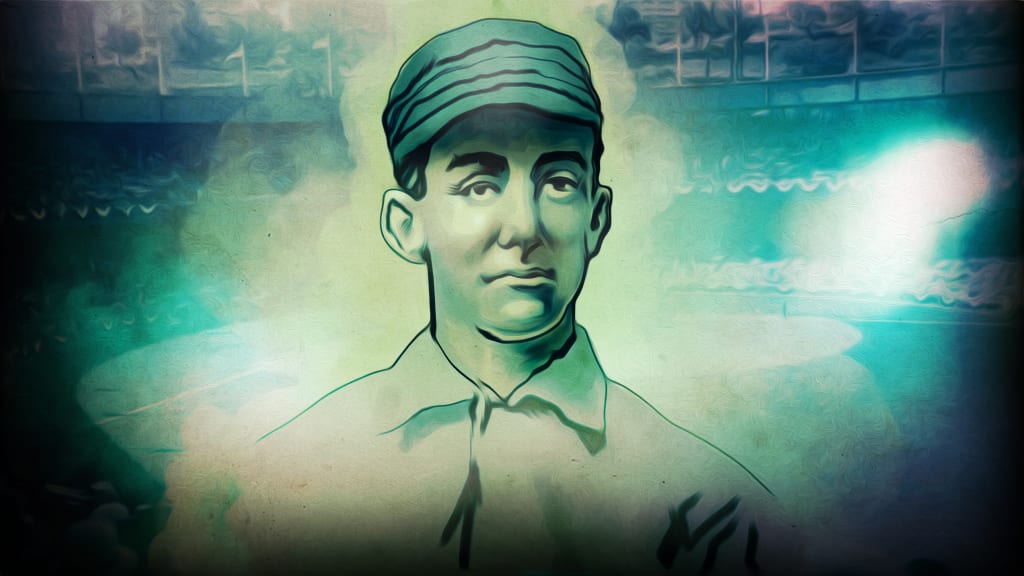
Imagine climbing Mount Everest, but not being able to plant a flag at the summit. That's basically what happened to former New York Giants outfielder Archibald Wright Graham. Affectionately known as "Moonlight," Graham appeared in exactly one Major League game.
You might recognize Graham’s name from the 1989 film “Field of Dreams,” a movie that still has MLB.com writers discussing its greatness to this day. But the legend of Archibald “Moonlight” Graham goes far beyond being a minor character in a fictional movie.
In case you haven’t seen “Field of Dreams” recently (or ever, which we'd highly recommend you rectify), here’s a summary of Graham’s character. Protagonist Ray Kinsella (portrayed by Kevin Costner) tracks down an elderly Graham (portrayed by Burt Lancaster) to discuss Graham’s lone career MLB appearance, when he played one inning in the field and had no plate appearances in the final game of the 1922 season. Graham reveals to Kinsella how much he yearned for that single chance to step in an MLB batter’s box even 50 years later, and after Kinsella departs, he encounters a hitchhiker who turns out to be the teenage version of Graham (portrayed by Frank Whaley). The younger Graham finally gets his chance to hit at Kinsella’s field, hitting a sac fly in his lone plate appearance, before he willingly sacrifices the opportunity to continue playing by stepping off the field (reverting to his adult self) and helping rescue Ray’s daughter, Karin, from choking on a hot dog.
At its core, a movie that features time travel, voices from the sky, and dead people playing baseball is obviously a fantasy film. But despite that genre classification, “Moonlight” Graham was very much a real person, one whose story only very slightly varied from the one featured on the big screen.
We can start with the game itself. To be sure, the movie did take some factual liberties. In reality, Graham’s lone MLB game came on June 29, 1905, rather than on the final day of the 1922 season. In the movie, Graham only played one defensive inning, but a very thorough biography about Graham by the Society of American Baseball Research reports that Graham played two innings in right field. The movie version of Graham had only been called up three weeks prior to the end of the season, but the real Graham was signed by the Giants in February 1905 and physically joined the team on May 13, after finishing medical exams. Likewise, Graham is depicted as a right-handed batter in the movie, but his Baseball Reference page verifies that he hit as a lefty.
But, details be damned, the movie’s overall narrative of “Moonlight” Graham’s short-lived MLB career was very similar to how it played out. In real life, Graham and the Giants (then located in New York) were on the road facing the Brooklyn Superbas -- the franchise now known as the Dodgers. Entering the game with a 46-18 record (compared to Brooklyn’s 17-47), the Giants dominated from the get-go, aided by five scoreless innings from future Hall of Famer Christy Mathewson.
Player-manager John McGraw had been clearing his bench throughout the later innings of the game. The 27-year-old Graham, who, according to The Evening World, became known as “Moonlight” because “he is supposed to be as fast as a flash,” replaced right fielder George Browne in the bottom of the eighth. Graham played the eighth inning, finished the top of the ninth in the on-deck circle as Giants pitcher Claude Elliott popped out to end the frame, and then played the bottom of the ninth in New York’s 11-1 win.
Both in the movie, and in real life: one appearance, zero stats.
Where the film and reality differ somewhat is in what happened after the game. In the movie, not only does the game end the season, but it also ends Graham’s professional baseball career as a whole. The elderly Graham tells Kinsella that he knew he would be sent down to the Minors by the start of the ensuing season, and he couldn’t bear the thought of returning to that level after getting a taste of the big leagues. As a result, he decided to retire and embark on a career in medicine.
In reality, the 1905 Giants were just getting started. New York went on to finish that season with an MLB-best 105-48-2 record en route to a World Series championship. Graham would not be part of that title run even from a bench capacity, though, after he was sold on July 5 to the Scranton Miners of the New York State League (a Minor League that last existed in 1917, and also included teams from Pennsylvania). SABR speculated that Graham’s release from the Giants was partially due to a football-related injury -- he also played for the University of Maryland’s football team in 1904 and 1905 while in medical school there -- though that will always remain unknown.
Regardless of the reasoning for his demotion, Graham played out the rest of the 1905 season in the Minors. But unlike his movie counterpart, he gave it a few more years before hanging them up. Graham reported to the Giants in Spring Training in 1906, but according to SABR, “McGraw had made up his mind on who would make his eighteen-man roster” -- with SABR hinting that McGraw was dismayed at Graham’s attempts to balance baseball with school.
Though Graham had a stellar season in 1906, leading the NYSL with a .336 average with the Miners, it was not enough for him to ever crack the big leagues again. He played two more seasons for Scranton in 1907 and 1908 before finally retiring from professional ball.
So what makes Graham so interesting? After all, according to MLB.com, there are at least 35 other known instances of players who appeared in MLB games but had zero career plate appearances. The answer to that question largely lies in what came after baseball for Graham. And in that regard, the movie nailed his real-life path to a tee.
Most of Graham’s young life and baseball career came on the East Coast (he went to University of North Carolina as an undergrad, and also began his Minor League career in Charlotte), and he initially intended to start his medical practice in Scranton. But shortly after his pro baseball retirement, he decided to move west to seek a better climate to solve his respiratory problems, and he eventually settled in Chisholm, Minn. -- the same city Kinsella drove to in an effort to track down Graham in the movie.
From that point, Graham’s second professional career took off, and he quickly became one of the most successful and beloved doctors in Chisholm. Almost immediately, “Moonlight” became the trusted physician to immigrant miners and their families who had come to America from Eastern Europe. He specifically helped Chisholm have a low death rate when a typhoid epidemic spread through the area in 1910.
During his early years in Minnesota, he dabbled in some semi-pro baseball and was successful enough that in 1911, scout Jack Sheridan reportedly gave Graham the opportunity to return to professional baseball with the Red Sox. But he declined the offer due to his burgeoning medical career, one which would only continue to grow in the years to come.
He greatly helped the city during a nationwide polio epidemic in 1914. In 1917, he met James P. Vaughan, who was the superintendent of schools in Chisholm, and then became the physician for Vaughan’s city school system. He also became the team doctor for Chisholm High School’s athletic programs, allowing him to help real-life children just like how the movie version of him saved little Karin Kinsella.
As he got deeper into his life, his renown only expanded. He contributed verbal presentations and written research to the likes of the Mayo Clinic, the American Journal of Diseases of Children and Northwestern University throughout the 1940s and 1950s. In June 1960, age finally caught up to Graham enough to the point where he retired from his duties as physician for the Chisholm public schools. But in his final years, he still remained involved in local affairs, even briefly becoming the treasurer of the Chisholm school system.
In 1965, Graham passed away at age 82. This was the final discrepancy between his life and the movie; in the film, he dies in 1972. But even after his death, his impact on the city he spent his entire adult life in was evident.
After his passing, friends in the community created an A.W. Graham Memorial Fund (his middle name was Wright) to help finance the Range Day Care Center for the mentally handicapped. Years later, in 1993, the Doc Graham Scholarship Foundation was started, which resulted in one boy and one girl per year from Chisholm High School receiving a financial stipend as a result of their contributions to their school and community.
As such, while the common baseball fan will always associate him with the “Field of Dreams” lore, the real story of Archibald “Moonlight” Graham goes far beyond that. Though his MLB career was as short as anyone’s in the history of the sport, when it came to helping people and making an impact on his community, Graham had the longest, most fruitful career a person could ask for.

